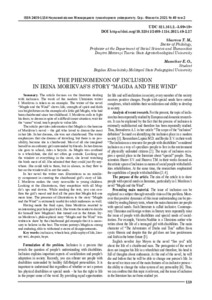Please use this identifier to cite or link to this item:
http://elar.tsatu.edu.ua/handle/123456789/15327| Title: | The phenomenon of inclusion in Irina Morikvas's story «Magda and the wind» |
| Other Titles: | Феномен інклюзії в оповіданні Ірини Мориквас «Магда і вітер» |
| Authors: | Sharova, Tetiana Шарова, Тетяна Михайлівна Шарова, Татьяна Михайловна Mamchur, E. O. |
| Keywords: | inclusion;wheelchair;philosophy of life;literary text;despair;hope;інклюзія;інвалідний візок;філософія життя;надія;розпач;художній текст |
| Issue Date: | 2021 |
| Series/Report no.: | Науковий вісник Міжнародного гуманітарного університету. Серія Філологія;№ 49, т. 2 (С. 119-123) |
| Abstract: | EN: The article focuses on the literature dealing with inclusion. The work of the modern Ukrainian writer I. Morikvas is taken as an example. The writer of the novel “Magda and the Wind” shows life, strength of spirit and faith in a bright future on the example of a little girl Magda, who had been chairbound since her childhood. I. Morikvas calls to fight his fears; to dream in spite of a difficult inner situation; wait for the “same” wind; teach people to value life. The article provides information that Magda is the heroine of Morikvas’s novel – the girl who loved to dream the most in her life. In her dreams, she was not chairbound. The writer emphasizes that she dreams of traveling, but there is no possibility, because she is chairbound. Most of all she imagined herself as an ordinary girl surrounded by friends. In her dreams she goes to school, rides a bicycle. As Magda was confined to a wheelchair, she did not often go outside. Looking out the window at everything in the street, she loved watching the birds most of all. She admired that they could just fly anywhere. She could talk to them, but in silence, as they flew to her on the windowsill to eat the seeds. In her novel the writer uses illustrations as an auxiliary component in creating the chairbound girl’s story of life. I. Morikvas makes the story accessible to young children. Looking at the illustrations, they empathize with all Magda’s ups and downs. While reading the text, you can confirm the girl’s mood and feel all the pain that Magda felt one more time. The presence of illustrations to the story “Magda and the Wind” is extremely useful for adult audiences as well. Having made the final open, Irina Morikvas resorted to an interesting psychological trick. She wants the reader to decide for himself how Magdina’s fate turned out in the future. Iryna Morikvas’s philosophical story “Magda and the Wind” was written to show by the chairbound girl example that it is necessary to believe in the best. The writer portrays Magda as strong and enduring, able to withstand a storm of disappointments. UK: У статті акцентується увага на літературі на тему інклюзії. Як приклад узята творчість сучасної української письменниці І. Мориквас. Письменниця в художньому тексті «Магда і вітер» показує життя, силу духу та віру в райдужне майбутнє на прикладі маленької дівчини Магди, прикутої до інвалідного візка. І. Мориквас закликає до того, аби бороти свої страхи, мріяти попри важке внутрішнє становище, дочекатися «того самого» вітру, навчити людей цінувати життя. У статті подана інформація про те, що Магда – героїня твору І. Мориквас – дівчинка, яка найбільше за все у своєму житті любила мріяти. У мріях вона не була прикута до інвалідного візка. Письменниця акцентує на тому, що вона мріє мандрувати, але не може, бо прикута до візка. Частіше за все вона уявляла себе звичайною дівчинкою, в якої є друзі. У мріях вона ходить до школи, їздить на велосипеді. Через те, що Магда була прикута до візка, вона не часто бувала на вулиці. Дивлячись через вікно на все, що відбувається на вулиці, найбільше вона полюбляла спостерігати за птахами. Вона захоплювалася тим, що вони можуть просто взяти та полетіти куди завгодно. Вона могла з ними говорити, але мовчки в той час, коли вони прилітали до неї на підвіконня, аби поїсти насіння. Художньому тексті письменниця використовує ілюстрації як допоміжний компонент у створенні історії життя дівчинки на візку. І. Мориквас робить оповідання доступним для дітей наймолодшого віку. Дивлячись на ілюстрації, вони співпереживають всі злети та падіння разом із Магдою. Читаючи текст, можна ще раз підтвердити побачений настрій дівчинки та відчути увесь біль, який відчувала Магда. Наявність ілюстрацій до оповідання «Магда і вітер», є надзвичайно корисними і для дорослої аудиторії. Зробивши фінал відкритим, Ірина Мориквас вдається до цікавого психологічного прийому. Вона бажає, аби читач сам вирішив, як надалі склалася доля Магдини. Філософське оповідання Ірини Мориквас «Магда і вітер» написано для того, аби на прикладі дівчинки в інвалідному візку показати, що треба вірити в краще. Письменниця зображує Магду сильною та витривалою, яка зможе вистояти перед буревієм розчарувань. |
| URI: | http://elar.tsatu.edu.ua/handle/123456789/15327 |
| DOI: | 10.32841/2409-1154.2021.49-2.27 |
| Appears in Collections: | кафедра Суспільно-гуманітарні науки |
Files in This Item:
| File | Description | Size | Format | |
|---|---|---|---|---|
| Шарова_Мамчур_Категорія Б_стаття.pdf | 576.16 kB | Adobe PDF |  View/Open |
Show full item record
CORE Recommender
???jsp.display-item.check???
Items in DSpace are protected by copyright, with all rights reserved, unless otherwise indicated.
